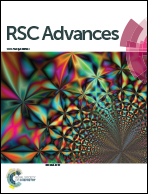Room temperature synthesis of manganese oxide quantum dots and their application as a fluorescent probe for the detection of metal ions in aqueous media†
Abstract
A rapid and facile route to access manganese oxide quantum dots (MOQDs) has been developed for the first time at room temperature by separating them from a manganese oxide nanosheet colloidal suspension using ultrafiltration. The size and thickness of the as-prepared MOQDs was 3.0–9.0 nm and 1.0–2.5 nm, respectively, which can be controlled by changing the molecular weight cut-off of the membrane. The photoluminescence behavior of the MOQDs is found to be strongly dependent on the excitation wavelength as well as particle size, but insignificant dependence on pH. Moreover, the MOQDs showed excellent long term resistance to photobleaching. The features of excellent photostability, mild pH variation and air resistance, make MOQDs a good candidate as a fluorescent probe for the detection of metal ions in aqueous media. The experiments of selectivity and competition towards various metal ions indicate that the MOQDs exhibit high selectivity for Mn2+ and Fe3+, and the other metal ions have an insignificant effect on the sensing system.


 Please wait while we load your content...
Please wait while we load your content...